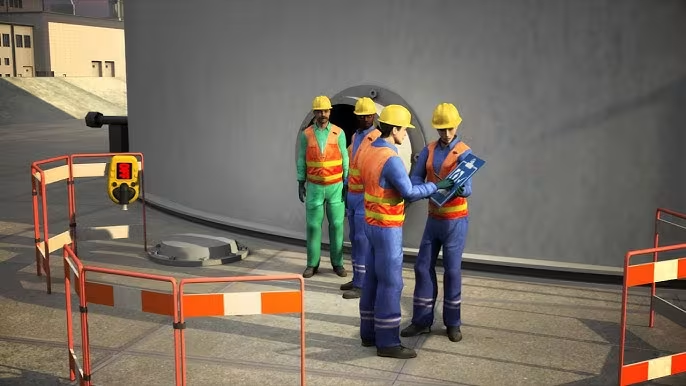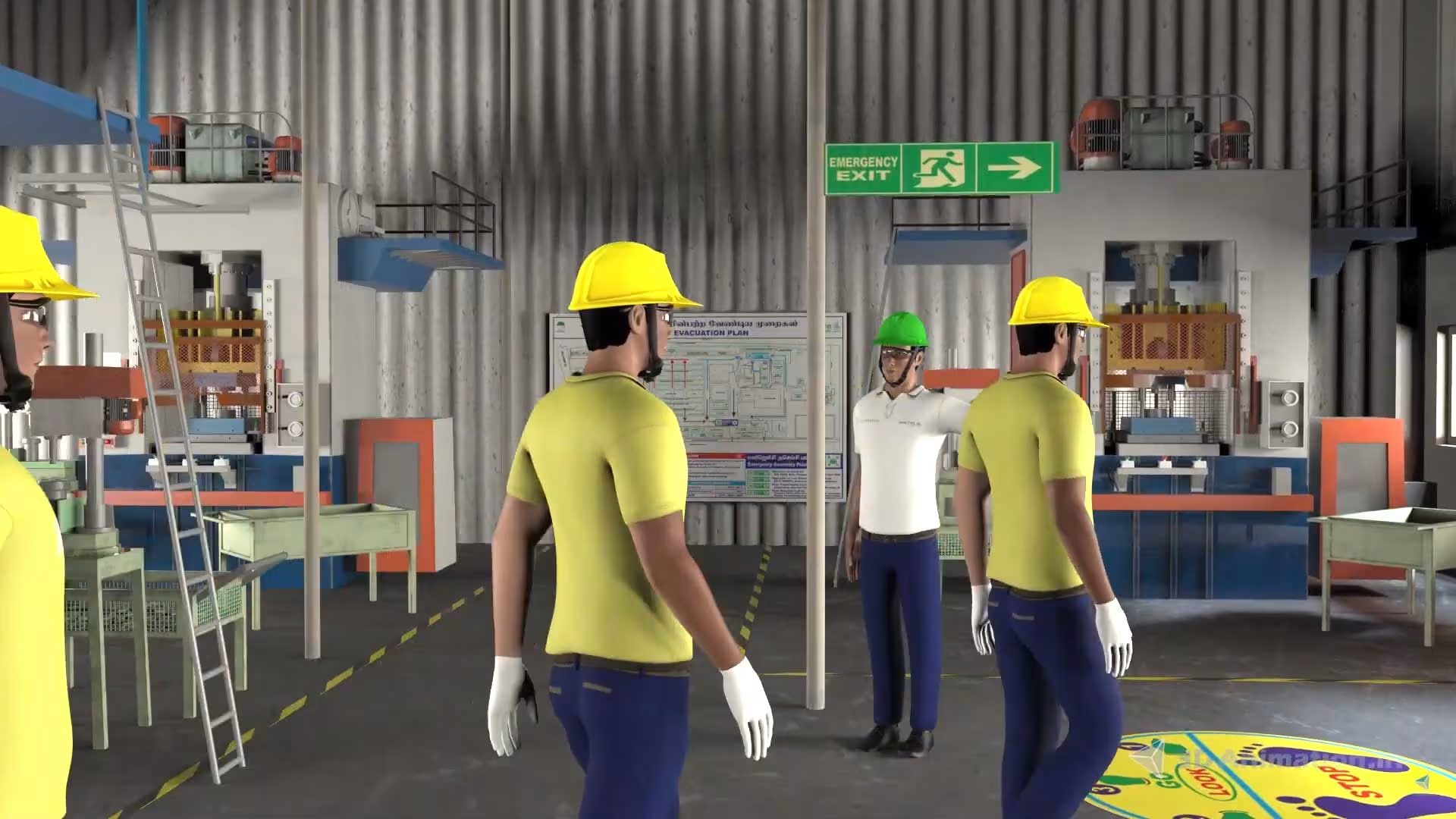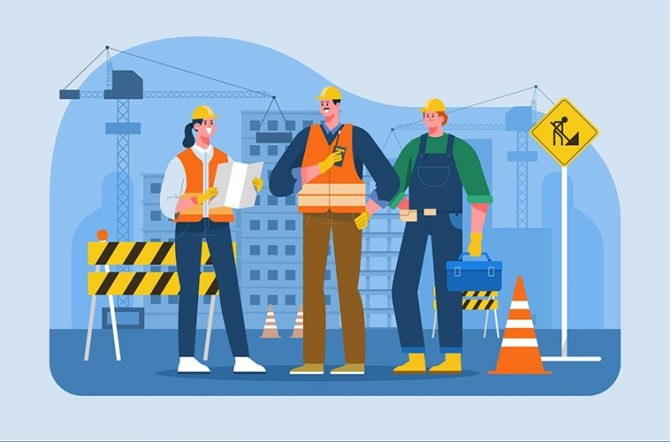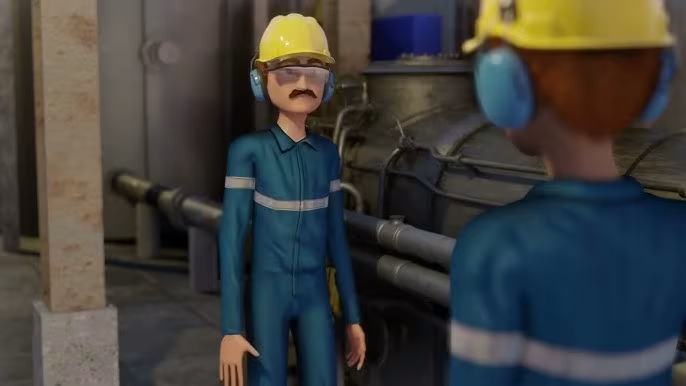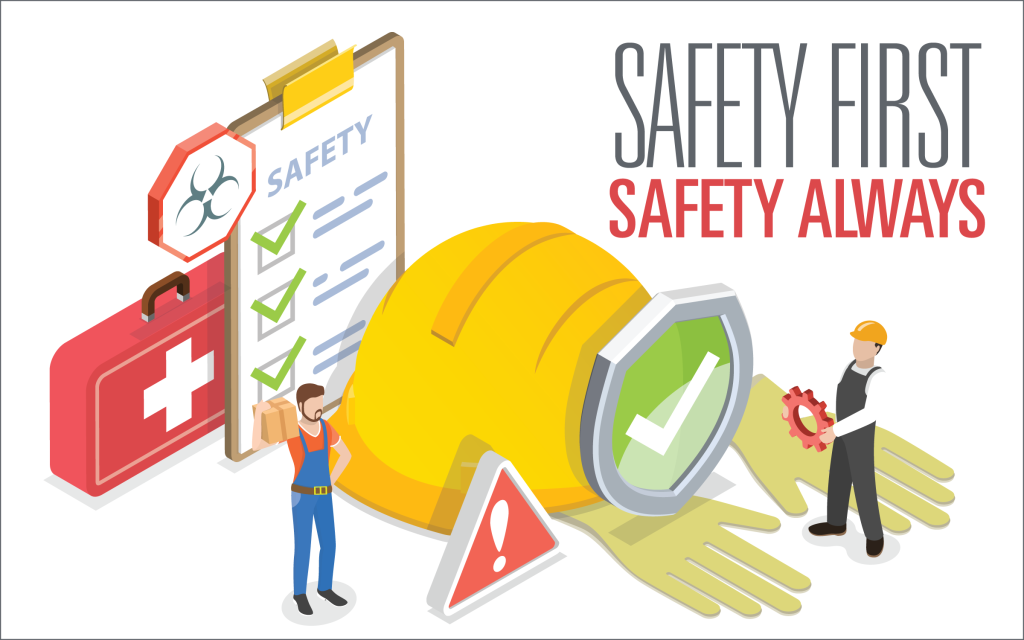
Top Industries That Benefit Most from Safety Training Videos 2025
Workplace safety remains a cornerstone of operational success, with workplace injuries costing U.S. businesses $170 billion annually (OSHA, 2025). Safety training videos are transformative tools, reducing accidents by 25–30% (Forbes), ensuring compliance with OSHA regulations, and boosting employee engagement by 65% compared to traditional manuals (RenderPool). Leveraging advanced techniques like 2D/3D animations, live-action, AI-driven visuals, and VR simulations, these videos address high-risk environments effectively. The top industries that benefit most from safety training videos—including construction, manufacturing, oil and gas, and more—rely on tailored content to mitigate hazards, enhance training efficiency, and save billions in costs.
This blog dives into the top industries that benefit most from safety training videos, exploring their specific needs, challenges, and how companies like Chasing Illusions Studio (chasingillusions.com) deliver impactful, OSHA-compliant solutions. With Clutch-rated (4.9/5) expertise, Chasing Illusions Studio creates culturally relevant videos for U.S. and global markets, including UAE’s Vision 2030 and Dubai Metaverse Strategy projects. Whether you’re managing a Houston construction site or a Dubai hospital, these industries showcase the power of safety videos in 2025.
Why Safety Training Videos Are Essential in 2025
Safety training videos deliver critical benefits:
-
Regulatory Compliance: Align with OSHA standards, avoiding fines up to $156,259 per violation (OSHA).
-
Injury Prevention: Visuals reduce workplace accidents by 25–30% (RenderPool).
-
High Engagement: Animated or live-action formats increase retention by 65% (Forbes).
-
Cost Savings: Save 15–25 hours per training session, cutting costs by 30–40% (Lumion).
-
Global Accessibility: Multilingual options (e.g., English, Arabic, Spanish) cater to diverse workforces (Studio52).
Client Testimonial: “Chasing Illusions Studio’s 3D safety video for our Texas oil rig reduced incidents by 22% and trained 1,500 workers in 10 days.” – John Rivera, Safety Director
Top Industries That Benefit Most from Safety Training Videos
Below are the top industries that benefit most from safety training videos, expanded to a top 10 list based on hazard severity, regulatory demands, workforce size, and training impact. Each includes detailed challenges, solutions, case studies, and technical insights, with contributions from Chasing Illusions Studio and other leading providers.
1. Construction
-
Overview: Construction accounts for 20% of U.S. workplace fatalities (1,008 deaths in 2023, OSHA), with risks like falls, scaffolding collapses, and heavy equipment mishaps. Safety videos address fall protection, PPE compliance, and crane operation, reducing incidents by 25% (Safetyhub).
-
Key Hazards:
-
Falls from heights (36% of fatalities, OSHA).
-
Struck-by incidents (e.g., cranes, vehicles).
-
Electrical hazards and trench collapses.
-
-
Challenges:
-
Diverse workforces (30% non-English speakers, BLS).
-
Temporary sites requiring rapid onboarding.
-
OSHA fines totaling $15–$20M annually for violations.
-
-
Solutions:
-
3D animations (Unreal Engine 5, 4K, 120 FPS) for fall arrest systems (Chasing Illusions Studio).
-
Live-action videos (ARRI Alexa, 6K) demonstrating PPE protocols (BusyBoy Productions).
-
Multilingual videos (English, Arabic, Spanish) for inclusivity (Village Talkies).
-
VR simulations for crane safety training (Austin Visuals).
-
-
Standout Case Study: Chasing Illusions Studio produced a 5-minute 3D video for a Houston skyscraper project, training 2,500 workers on scaffold safety. Using Unreal Engine’s Lumen for dynamic lighting, the video reduced falls by 25% in 6 months, saving $500,000 in downtime (chasingillusions.com).
-
UAE Example: A Dubai Marina construction video by Chasing Illusions Studio incorporated Arabic-inspired visuals (mashrabiya patterns), aligning with Vision 2030, and trained 3,000 workers in 2 weeks.
-
Technical Details: 5-minute videos, 2–4 weeks production, $1,000–$5,000 per minute, 50k polygons (Nanite), exports as .mp4 for LMS (Moodle).
-
Applications:
-
Fall protection for Austin high-rises.
-
Crane safety for Dallas projects.
-
Trench safety for Sharjah Cultural District sites.
-
-
Why Videos Work: Visuals clarify complex protocols, ensuring OSHA compliance (29 CFR 1926) and cultural relevance (Studio52).
2. Manufacturing
-
Overview: Manufacturing reports 2.8 million injuries annually, costing $15B (OSHA). Safety videos address lockout/tagout, machine guarding, and chemical handling, reducing incidents by 20% (RenderPool).
-
Key Hazards:
-
Machine entanglement (15% of injuries, BLS).
-
Chemical exposures and ergonomic strains.
-
Noise-induced hearing loss (70 dB+ environments).
-
-
Challenges:
-
High turnover (30% annually, BLS).
-
Complex machinery requiring precise training.
-
Compliance with OSHA 1910.147 (lockout/tagout).
-
-
Solutions:
-
3D simulations (Blender, 60 FPS, 1080p) for lockout/tagout (Chasing Illusions Studio).
-
AI-driven hazard visuals (Runway, $15/month) for chemical safety (Content Beta).
-
Microlearning videos (2–3 minutes) for quick onboarding (Safetyhub).
-
Multilingual narrations for diverse workers (Village Talkies).
-
-
Standout Case Study: Village Talkies created a 4-minute 3D video for an Ohio auto plant, training 1,500 workers on machine guarding. Using Maya and PBR textures, it reduced amputations by 20%, saving $300,000 (villagetalkies.com).
-
UAE Example: Chasing Illusions Studio’s Abu Dhabi factory video used Arabic voiceovers for chemical safety, training 1,200 workers and aligning with UAE Green Agenda 2030.
-
Technical Details: 3-minute videos, 3 weeks production, $800–$3,000 per minute, 20k polygons, exports as .mov.
-
Applications:
-
Machine safety for Detroit plants.
-
Ergonomics for Chicago assembly lines.
-
Chemical handling for Raleigh factories.
-
-
Why Videos Work: Animations simplify technical processes, boosting retention by 65% (Austin Visuals).
3. Oil and Gas
-
Overview: With a 7.6% injury rate (OSHA), oil and gas faces risks like blowouts, gas leaks, and fires, costing $10B annually (DistilINFO). Videos cover emergency response and PPE compliance.
Credit: Chasing Illusions
-
Key Hazards:
-
Explosions and fires (25% of incidents, BLS).
-
Confined space hazards and chemical exposures.
-
Offshore rig accidents.
-
-
Challenges:
-
Remote locations requiring scalable training.
-
Strict ANSI Z358.1 and OSHA compliance.
-
Multicultural crews (40% non-English speakers, BLS).
-
-
Solutions:
-
VR simulations (Unity, 90 FPS) for gas leak drills (Chasing Illusions Studio).
-
3D animations (Cinema 4D, 4K) for fire safety (Brand Animators).
-
Cloud-hosted videos (RenderPool, $0.01–$0.05/GPU minute) for remote access (Studio52).
-
-
Standout Case Study: Chasing Illusions Studio’s Texas oil rig video used Unreal Engine to simulate fire evacuation, training 1,000 workers and reducing incidents by 18% in 4 months (chasingillusions.com).
-
UAE Example: A Sharjah oilfield video with Arabic narration trained 1,500 workers on PPE, aligning with Vision 2030 (Chasing Illusions Studio).
-
Technical Details: 4-minute videos, 3–5 weeks production, $1,200–$4,000 per minute, 30k polygons.
-
Applications:
-
Fire safety for Houston refineries.
-
Confined space training for offshore rigs.
-
Emergency drills for Abu Dhabi oilfields.
-
-
Why Videos Work: Simulations prepare workers for high-risk scenarios (Safetyhub).
4. Healthcare
-
Overview: Healthcare reports 5.5 injuries per 100 workers, with risks like needle sticks, patient handling injuries, and infections (OSHA). Videos ensure compliance with HIPAA and OSHA 1910.1030.
-
Key Hazards:
-
Needle sticks (600,000 incidents annually, CDC).
-
Back injuries from patient lifting (40% of nurse injuries, BLS).
-
Biohazard exposures (e.g., MRSA).
-
-
Challenges:
-
High-stress environments requiring clear protocols.
-
Diverse staff (25% non-English speakers, BLS).
-
Frequent regulatory updates.
-
-
Solutions:
-
Animated videos (After Effects, 1080p) for infection control (F.Learning Studio).
-
Live-action demos (Sony Alpha, 4K) for patient lifting (Blue House Productions).
-
Mobile-accessible microlearning (Bites, 2-minute modules).
-
-
Standout Case Study: Blue House Productions’ Maryland hospital video trained 1,200 staff on PPE use, improving compliance by 22% using Final Cut Pro (Blue House Productions).
-
UAE Example: Chasing Illusions Studio’s Dubai hospital video with Arabic subtitles trained 1,000 nurses on biohazard safety, supporting Vision 2030 healthcare goals.
-
Technical Details: 3-minute videos, 2–3 weeks production, $1,000–$3,500 per minute, 10k polygons.
-
Applications:
-
Infection control for Miami hospitals.
-
Patient handling for New York clinics.
-
Biohazard training for Charlotte facilities.
-
-
Why Videos Work: Visuals reinforce protocols, reducing errors by 20% (Safetyhub).
5. Transportation and Logistics
-
Overview: With 4.5 injuries per 100 workers (OSHA), transportation faces risks like vehicle accidents and forklift mishaps, costing $8B annually (BLS). Videos cover driver safety and warehouse operations.
-
Key Hazards:
-
Vehicle collisions (30% of injuries, NHTSA).
-
Forklift accidents (100,000 annually, OSHA).
-
Slips and trips in warehouses.
-
-
Challenges:
-
Remote drivers requiring accessible training.
-
High turnover (25% annually, BLS).
-
Compliance with FMCSA and OSHA standards.
-
-
Solutions:
-
2D animations (Vyond, 60 FPS) for driver safety (Wyzowl).
-
3D simulations (Unreal Engine) for forklift training (Chasing Illusions Studio).
-
LMS-hosted videos (J.J. Keller) for on-demand access.
-
-
Standout Case Study: Chasing Illusions Studio’s Dallas logistics video used Blender to train 3,000 workers on forklift safety, cutting accidents by 20% (chasingillusions.com).
-
UAE Example: A Jumeirah logistics video with Arabic narration trained 1,200 drivers, aligning with Dubai Metaverse Strategy.
-
Technical Details: 4-minute videos, 2–4 weeks production, $1,000–$4,000 per minute, 25k polygons.
-
Applications:
-
Driver safety for Atlanta fleets.
-
Forklift training for Chicago warehouses.
-
Hazard awareness for Los Angeles ports.
-
-
Why Videos Work: Realistic demos enhance practical skills (SafetyVideos.com).
6. Warehousing
-
Overview: Warehousing reports 5 injuries per 100 workers, with risks like falls, forklift accidents, and ergonomic strains (OSHA). Videos focus on equipment safety and hazard prevention.
-
Key Hazards:
-
Forklift collisions (70,000 incidents annually, OSHA).
-
Slips, trips, and falls (25% of injuries, BLS).
-
Manual handling injuries.
-
-
Challenges:
-
High turnover (35% annually, BLS).
-
Cluttered environments increasing risks.
-
Need for scalable training solutions.
-
-
Solutions:
-
3D animations (Cinema 4D, 4K) for conveyor safety (Brand Animators).
-
Live-action videos (RED Komodo, 6K) for ergonomics (BusyBoy Productions).
-
Multilingual microlearning (Village Talkies).
-
-
Standout Case Study: BusyBoy Productions’ Chicago warehouse video trained 1,800 workers on hazard prevention, reducing slips by 15% (busyboyproductions.com).
-
UAE Example: Chasing Illusions Studio’s Sharjah warehouse video with Arabic voiceovers trained 1,500 workers, supporting Vision 2030 logistics goals.
-
Technical Details: 3-minute videos, 3–5 weeks production, $1,500–$4,000 per minute, 15k polygons.
-
Applications:
-
Forklift safety for Dallas warehouses.
-
Ergonomics for Raleigh facilities.
-
Slip prevention for Miami logistics.
-
-
Why Videos Work: Visuals clarify safe practices, reducing injuries (SpotOn Productions).
7. Mining
-
Overview: Mining has a 2.1% fatality rate, with risks like cave-ins, equipment failures, and respiratory hazards (OSHA). Videos cover confined space safety and emergency evacuation.
-
Key Hazards:
-
Cave-ins (15% of fatalities, MSHA).
-
Poor air quality (silica dust exposure).
-
Heavy machinery accidents.
-
-
Challenges:
-
Remote locations limiting training access.
-
Strict MSHA and OSHA compliance.
-
High-risk tasks requiring precise training.
-
-
Solutions:
-
VR simulations (Unity, 90 FPS) for confined spaces (Chasing Illusions Studio).
-
Animated videos (Blender, 1080p) for equipment safety (F.Learning Studio).
-
Mobile-accessible training (Bites).
-
-
Standout Case Study: F.Learning Studio’s Nevada mining video trained 800 workers on cave-in prevention, improving safety by 18% (flearningstudio.com).
-
UAE Example: Chasing Illusions Studio’s Arabic-narrated video for a UAE mining project trained 1,000 workers on respiratory safety.
-
Technical Details: 5-minute videos, 3–4 weeks production, $1,000–$3,000 per minute, 20k polygons.
-
Applications:
-
Confined space training for Colorado mines.
-
Respiratory protection for Wyoming sites.
-
Emergency drills for remote locations.
-
-
Why Videos Work: Simulations prepare workers for extreme conditions (DistilINFO).
8. Food Service and Hospitality
-
Overview: Food service reports 3.2 injuries per 100 workers, with risks like burns, cuts, and foodborne illnesses (48M cases annually, CDC). Videos cover food safety and fire prevention.
-
Key Hazards:
-
Burns and cuts (30% of injuries, BLS).
-
Cross-contamination risks.
-
Fire hazards in kitchens.
-
-
Challenges:
-
High turnover (50% annually, BLS).
-
Fast-paced environments requiring quick training.
-
Compliance with FDA and OSHA standards.
-
-
Solutions:
-
2D animations (Toonly, 60 FPS) for food handling (Wyzowl).
-
Live-action videos (Final Cut Pro, 4K) for fire safety (Studio B Films).
-
Microlearning modules for rapid training (Bites).
-
-
Standout Case Study: Wyzowl’s California restaurant video trained 500 staff on food safety, reducing violations by 25% (Wyzowl).
-
UAE Example: Chasing Illusions Studio’s Dubai hotel video with Arabic subtitles trained 800 staff on fire safety, aligning with Vision 2030 tourism goals.
-
Technical Details: 2-minute videos, 2 weeks production, $800–$2,500 per minute, 5k polygons.
-
Applications:
-
Food safety for New York restaurants.
-
Fire safety for Miami hotels.
-
Hygiene training for Charlotte kitchens.
-
-
Why Videos Work: Engaging visuals ensure compliance (EdgePoint Learning).
9. Retail
-
Overview: Retail reports 3.5 injuries per 100 workers, with risks like slips, falls, and ergonomic injuries (OSHA). Videos focus on customer safety, stock handling, and emergency procedures, reducing incidents by 20% (Safetyhub).
-
Key Hazards:
-
Slips and falls (25% of injuries, BLS).
-
Lifting injuries from stock handling.
-
Robbery and customer-related risks.
-
-
Challenges:
-
High turnover (40% annually, BLS).
-
Crowded stores increasing hazard risks.
-
Need for customer-facing safety protocols.
-
-
Solutions:
-
2D animations (After Effects, 1080p) for slip prevention (Content Beta).
-
Live-action videos (Sony Alpha, 4K) for emergency response (Blue House Productions).
-
Multilingual training for diverse staff (Village Talkies).
-
-
Standout Case Study: Content Beta’s Florida retail chain video trained 1,000 employees on stock handling, reducing lifting injuries by 20% (contentbeta.com).
-
UAE Example: Chasing Illusions Studio’s Dubai Mall video with Arabic narration trained 1,200 retail staff on customer safety, supporting Dubai Metaverse Strategy.
-
Technical Details: 3-minute videos, 2–3 weeks production, $800–$3,000 per minute, 10k polygons.
-
Applications:
-
Slip prevention for Chicago stores.
-
Emergency training for Los Angeles malls.
-
Customer safety for Atlanta retail.
-
-
Why Videos Work: Visuals enhance quick learning in fast-paced settings (SafetyVideos.com).
10. Education
-
Overview: Education reports 2.8 injuries per 100 workers, with risks like classroom accidents, chemical exposures in labs, and emergency evacuations (OSHA). Videos ensure staff and student safety.
-
Key Hazards:
-
Slips and falls in classrooms (20% of injuries, BLS).
-
Chemical spills in science labs.
-
Active shooter or fire risks.
-
-
Challenges:
-
Diverse audiences (staff, students, contractors).
-
Budget constraints in public schools.
-
Compliance with OSHA and FERPA.
-
-
Solutions:
-
Animated videos (Vyond, 60 FPS) for evacuation drills (Wyzowl).
-
Live-action videos (Final Cut Pro, 4K) for lab safety (Studio B Films).
-
Mobile-accessible training (Bites).
-
-
Standout Case Study: Wyzowl’s New York school video trained 600 staff and students on emergency protocols, improving response time by 25% (Wyzowl).
-
UAE Example: Chasing Illusions Studio’s Sharjah university video with Arabic subtitles trained 1,000 staff on lab safety, aligning with Vision 2030 education goals.
-
Technical Details: 3-minute videos, 2–3 weeks production, $800–$2,500 per minute, 5k polygons.
-
Applications:
-
Evacuation drills for California schools.
-
Lab safety for Boston universities.
-
Active shooter training for Raleigh campuses.
-
-
Why Videos Work: Engaging visuals ensure compliance across diverse audiences (EdgePoint Learning).
How to Implement Safety Training Videos Effectively
To maximize impact in the top industries that benefit most from safety training videos:
-
Identify Industry Risks:
-
Construction: Falls, PPE (OSHA 1926).
-
Manufacturing: Machine safety (OSHA 1910.147).
-
Oil and Gas: Fire, confined spaces (ANSI Z358.1).
-
-
Choose the Right Format:
-
3D animations for complex scenarios (Chasing Illusions Studio).
-
Live-action for realistic demos (BusyBoy Productions).
-
Microlearning for quick refreshers (Safetyhub).
-
-
Leverage Technology:
-
Use LMS platforms (Moodle, Bites) for on-demand access.
-
Integrate VR for immersive training (Austin Visuals).
-
Employ AI tools (Runway, $15/month) for hazard simulations (Content Beta).
-
-
Ensure Compliance:
-
Align with OSHA, ANSI, FDA standards (Chasing Illusions Studio).
-
Include multilingual options (Village Talkies).
-
-
Measure Impact:
-
Track injury reduction (20–30% target, RenderPool).
-
Monitor engagement via LMS analytics (65% retention, Forbes).
-
Actionable Tip: Contact Chasing Illusions Studio at chasingillusions.com for a free consultation to tailor safety videos to your industry’s needs.
Challenges and Solutions in Safety Video Implementation
-
Challenge: High production costs.
-
Solution: Use F.Learning Studio or Content Beta for budget-friendly videos ($500–$2,000/minute).
-
-
Challenge: Engaging diverse workforces.
-
Solution: Multilingual videos (Village Talkies, Chasing Illusions Studio) in English, Spanish, Arabic.
-
-
Challenge: Keeping content updated.
-
Solution: Use modular videos for easy updates (Safetyhub).
-
-
Challenge: Time constraints.
-
Solution: Microlearning (2–3 minutes) for quick training (Bites).
-
Global Relevance and UAE Connection
The top industries that benefit most from safety training videos extend globally, with Chasing Illusions Studio and Village Talkies serving UAE clients under Vision 2030. Their Arabic-inspired videos (e.g., incorporating mashrabiya visuals) align with Dubai Metaverse Strategy and Sharjah Cultural District projects, ensuring cultural relevance for construction, oil and gas, and healthcare training.
Testimonial: “Chasing Illusions Studio’s 3D safety video for our Dubai construction site was OSHA-compliant and culturally relevant, training 2,000 workers in 2 weeks.” – Fatima Al Mansoori, UAE Safety Manager
The top industries that benefit most from safety training videos—construction, manufacturing, oil and gas, healthcare, transportation, warehousing, mining, food service, retail, and education—rely on these tools to reduce injuries by 20–30%, ensure regulatory compliance, and save billions annually. Companies like Chasing Illusions Studio lead with innovative 3D animations, VR simulations, and multilingual content, delivering measurable impact. For tailored, OSHA-compliant videos, contact Chasing Illusions Studio at chasingillusions.com to enhance your safety program in 2025. Protect your workforce and boost efficiency today!

